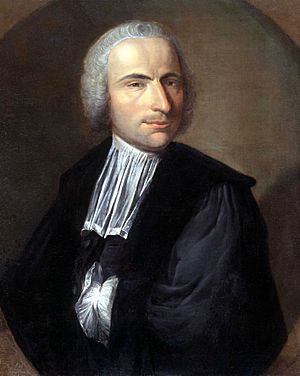Jean-Nicolas-Sébastien Allamand facts for kids
Jean-Nicolas-Sébastien Allamand (also known as Johannes Nicolaas Sebastiaan Allamand) was a Swiss-Dutch scientist. He was born on October 18, 1716, or possibly September 18, 1713, and passed away on March 2, 1787. He was very important in the fields of physics, chemistry, and natural history.
Contents
Allamand's Life and Studies
Early Life and Education
Jean-Nicolas-Sébastien Allamand was born in Lausanne, Switzerland. He first studied theology, which is the study of religion. Later, he moved to the Netherlands. There, he focused on mathematics, physics, chemistry, and natural history in the city of Leiden.
He met a famous scientist named Willem 'sGravesande. 'sGravesande trusted Allamand to teach his two sons. He also made Allamand the person who would manage his affairs after he died. Allamand learned a lot more about physics with 'sGravesande's help.
A Professor in Science
With strong support from 'sGravesande, Allamand became a professor of philosophy. This happened at the University of Franeker on March 3, 1747. Just two years later, he was invited back to the University of Leiden. There, he became a professor of mathematics and philosophy. He accepted this new job on May 30 with a special speech. The speech was called On the True Philosopher, and it mostly praised his mentor, 'sGravesande.
In 1747, Allamand was also chosen to be a Fellow of the Royal Society. This is a very old and respected group for scientists.
Collecting Natural Wonders
Allamand was very important for building and growing a special collection at the University. This was called the Cabinet of Natural History. It was a place where natural objects and specimens were kept.
He also used his own money to create his own collection. He called it the Cabinet of Natural Rarities. During his lifetime, students could visit this collection in a hall behind the Academy building. When he passed away on March 2, 1787, he gave this entire collection to the University. He also helped the Cabinet of Antiquities, which was a collection of old artifacts. Allamand did not have any children with his wife, Margaretha Crommelin.
Allamand's Scientific Contributions
Books and Translations
Allamand added many new details and descriptions to the Dutch version of Buffon's famous book, Histoire Naturelle. This book was about animals and nature.
He also prepared the writings of his mentor, 'sGravensande, for publication. These were called Oeuvres philosophiques et mathématiques (Philosophical and Mathematical Works). This work came out in two volumes in 1774 and included 28 illustrations. Allamand also edited the Geschiedkundig Woordenboek (Historical Dictionary) by Prosper Marchand.
Allamand translated many important scientific books into Dutch. He translated:
- Brisson's Dierenrijk (Animal Kingdom) from Latin in 1762. He added many of his own notes to this book.
- Oliver's Verhandeling over de Kometen (Treatise on Comets) from French in 1777.
- H. Hopp's new description of Cape Good Hope from French in 1778.
- A reading by Jakob Forster about different subjects, published in Leiden in 1793.
- Herman Boerhaave's Elementen der scheikunde (Elements of Chemistry).
- Ellis's Natuurlijke Historie van de Koraalgewassen en andere Zeeligchamen (Natural History of Corals and other Sea Bodies) from French in 1756. This book also had illustrations.
Understanding the Leyden Jar
Allamand wrote several essays about physics. He is known for giving the very first explanation of how the Leyden jar worked. The Leyden jar was an early type of electrical capacitor, used to store static electricity.


